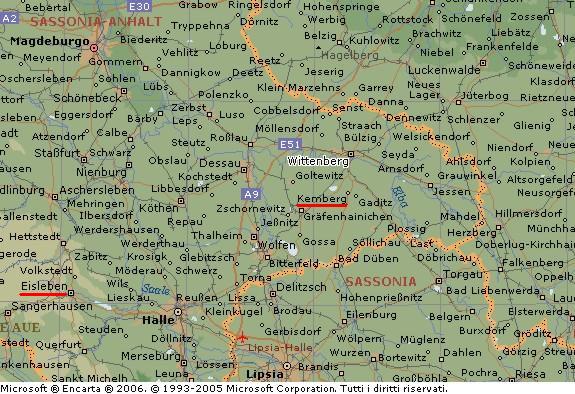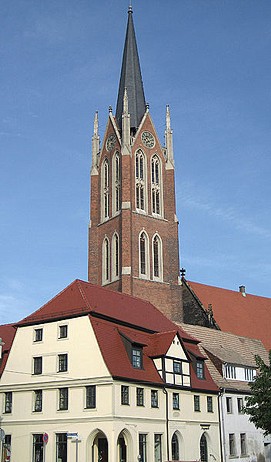Lessico
Kemberg
Kemberg è
un comune tedesco di 4.714 abitanti situato nel distretto di Wittenberg![]() nello
Stato federato della Sassonia-Anhalt la cui capitale è Magdeburgo. Il centro
di Kemberg e quello di Wittenberg distano 10,9 km in linea retta, mentre
Gessner a pagina 451
nello
Stato federato della Sassonia-Anhalt la cui capitale è Magdeburgo. Il centro
di Kemberg e quello di Wittenberg distano 10,9 km in linea retta, mentre
Gessner a pagina 451![]() di Historia
animalium III (1555) afferma che le due città distano un miglio,
verosimilmente un miglio romano - pari a 1,48 km - visto che ce lo tramanda in
latino: Kembergi uno a Vuitemberga
miliario. Non sappiamo a quanto equivalesse il miglio di Zurigo,
ammesso che esistesse. Può darsi che
Gessner facesse riferimento alla distanza fra Kemberg e la periferia del
territorio di Wittenberg. Oppure che colui che gli aveva fornito la distanza
tra le due città intendesse per miglio quello olandese di un tempo, visto che
Wittenberg era stata fondata nel XII secolo da immigrati provenienti
dalle Fiandre. Il vecchio miglio olandese era pari a 7408 m. Praticamente
equivalenti erano i valori in aree di lingua tedesca: miglio austriaco = 7585
m, miglio del Reno (di Prussia) = 7532 m. L'ideale assai improbabile è che il
miglio riferito da Gessner corrispondesse al vecchio miglio norvegese, 11.295
m, praticamente equivalente alla nostra misurazione in linea d'aria.
di Historia
animalium III (1555) afferma che le due città distano un miglio,
verosimilmente un miglio romano - pari a 1,48 km - visto che ce lo tramanda in
latino: Kembergi uno a Vuitemberga
miliario. Non sappiamo a quanto equivalesse il miglio di Zurigo,
ammesso che esistesse. Può darsi che
Gessner facesse riferimento alla distanza fra Kemberg e la periferia del
territorio di Wittenberg. Oppure che colui che gli aveva fornito la distanza
tra le due città intendesse per miglio quello olandese di un tempo, visto che
Wittenberg era stata fondata nel XII secolo da immigrati provenienti
dalle Fiandre. Il vecchio miglio olandese era pari a 7408 m. Praticamente
equivalenti erano i valori in aree di lingua tedesca: miglio austriaco = 7585
m, miglio del Reno (di Prussia) = 7532 m. L'ideale assai improbabile è che il
miglio riferito da Gessner corrispondesse al vecchio miglio norvegese, 11.295
m, praticamente equivalente alla nostra misurazione in linea d'aria.


Markt church tower
Kemberg is a municipality in Wittenberg district in Saxony-Anhalt, Germany, and the seat of the administrative municipality (Verwaltungsgemeinschaft) of Kemberg. The town lies on the north edge of the Dübener Heide Nature Park. Kemberg includes the subdivisions of Bergwitz, Klitzschena, and Ateritz. On 1 July 2005, the municipality of Bergwitz with its subdivision of Klitzschena, was amalgamated with Kemberg, as was the municipality of Ateritz (with its subdivisions of Gommlo and Lubast) on 1 January 2006.
The town's most striking sight is the soaring Church of Our Lady ("Unser Lieben Frauen") which can be seen far away over the Elbaue (natural polder). It is a hall church with a nave and two aisles dating from the 15th century (or so it is believed) with an 86-m-tall tower built in the 19th century. There are things there such as remnants of wall paintings from the late Middle Ages, a sacrament house made of sandstone and a carved altar (both from the 15th century) and a very nice baptismal font. Also worth seeing are the late Gothic town hall with its Renaissance additions and the old town wall from the 14th century, parts of which are still well preserved. Kemberg's well preserved town centre takes the visitor to bygone days and is always worth seeing on foot. The town is also well placed for outings to the nearby heath, and to Wittenberg.